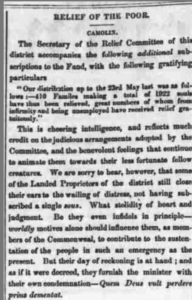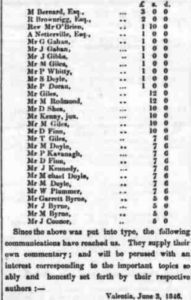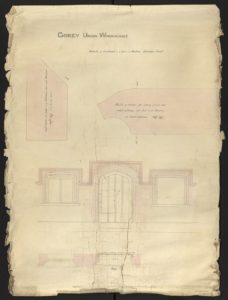What was a Poor Law Union
In the early 19th century, Ireland was a place of widespread poverty. The Irish Poor Laws, a series of Acts of Parliament, were designed to deal with the social problems caused by extreme poverty in Ireland. The Irish Poor Law Act of 1838 followed a similar Act in England in 1834. It resulted in the country being divided into 130 administrative units called Poor Law Unions.
After the Poor Law Act was passed in 1838, the Commissioners discarded the use of the administrative units of the Barony and Civil Parish because they differed greatly in size to one another. New divisions called Poor Law Unions were created with each Union being funded by a poor rate set by the local Union.
Each Union had a workhouse established in its district and from where poor relief would be administered. Being selected as the market town in the Poor Law Union was a significant matter as the Poor Relief system generated business for local traders who supplied the workhouses.
A Board of ‘Poor Law Guardians’ (who were elected or appointed by local magistrates) administered the affairs of the Union. An additional Poor Law Union was created in 1848 and 32 more were added in 1850 after the Famine bringing the total to 163.
Initially, it was projected that the new system of Unions would cater for approximately 80,000 impoverished people (c.1% of the population). However, by 1851 the Great Famine had driven nearly 300,000 people (c.4% of the population) into workhouses. This number does not include those who received ‘Outdoor Poor Relief’. As time passed, the Poor Law Unions became the centre for administration for many services such as housing, sanitation, and health.
The Local Government Act 1898 resulted in the transfer of housing and sanitation functions from the Poor Law Unions to the newly established District Councils. Poor Law Unions were mostly abolished, and eventually workhouses closed in the south of Ireland in the 1920s. Many workhouses are evident in towns around the country today as district hospitals or county homes. County homes housed a wide range people such as the elderly, unmarried mothers, people with physical, and mental illness as well as adults and children with intellectual disabilities.
Read Understanding Ireland’s Administrative Units (scroll down to third heading) to learn about the new administrative divisions, Poor Law Unions and other historical divisions through the ages.
Gorey Poor Law Union Workhouse
In 1839, the Gorey Poor Law Union was officially announced, and building of a workhouse took place on a site at the south-west of Gorey. The workhouse served an area of 190 square miles and 10 electoral divisions. In 1841, the workhouse was opened with the capacity to house 500 people. It cost a total of €6,700 to construct, with building costs listed at £5,675 and fittings costing £1,025.
It’s worth remembering that the facilities and conditions in a workhouse were designed to punish people for their poverty and make being an inmate so horrible that people would continue to work at all costs in their communities. Despite the fact that workhouses were a place of last resort, dire poverty and starvation drove people there in large numbers.
First admissions to the Workhouse took place on the 22nd of January 1842. An extension was built during the Famine which added another 80 places to the workhouse. The number of inmates fluctuated over the years and reached a peak at the height of the famine in 1847 when the workhouse held 710 inmates.
There was a standard design template used for the construction of workhouses in Ireland. The plans were designed by an English architect, George Wilkinson. Typically, the workhouse consisted of an administrative centre at the front of a ‘H-shaped’ building hosting the wards for inmates and the school for children. Further back, there were two exercise yards, one for men and one for women.
At the rear of Gorey workhouse, there was a bakehouse and a washhouse which connected to a church and dining area, at the end of which the infirmary was located. There was a burial site on grounds to the north of the building and a fever hospital located on the southern side of the site.
The Gorey Board of Guardians consisted of 32 members, 24 of which were elected to represent the electoral divisions in the area. The other 8 members were appointed by the local magistrates. The Board held meetings weekly on Saturdays on the first floor of the administrative block. The work of the Board is recorded in its minutes which contain information on admissions, discharges, births, and deaths as well as records detailing the provision for paupers in the Union.
Many of the workhouses were later transformed into hospitals or county homes and are easily recognisable today in towns across the country. In the case of the Gorey workhouse, it was converted to a leather factory and, in later years, it was demolished except for the administrative block and cottage which remain.
Lord Grey, British Secretary of State for the Colonies, was responsible for the female emigration scheme (1848-50) whereby suitable female orphans were selected for transportation to Australia from Dublin or Cork via Plymouth. The scheme was established to meet the shortage of women in the colony where men outnumbered women 8:1. The Gorey Union records detail the female emigrant’s name, age, ability to read, write, spell, knit, sew, and wash. It also records the time spent in the workhouse.
Check out further details of this historic building (Reg No: 15701132) on the ‘National Inventory of Architectural Heritage’ website.
Commission inquiring into the number and boundaries of Poor Law unions and electoral divisions, 1849 Twelfth report - Gorey Union Extract
Courtesy of University of Southampton/JSTOR as per the Community Collection terms and conditions.
From this report in 1849, 11 years after the Poor Law Act of 1838, you will note that there were still proposed changes to the Electoral Divisions in Gorey Poor Law Union. The townlands in Balloughter Electoral Division listed in this report are the same as those listed today with the exception of the merging of both ‘Clonmores’ into one townland with the same name. Read more about this amalgamation at The Past/Historical Land Surveys/Tithe Applotments 1823-38.
Commissioners for Administering Laws for Relief of Poor in Ireland - Reports from 1848, 1858 and 1868 - Extracts
Courtesy of University of Southampton/JSTOR as per the Community Collection terms and conditions.
These pages provide a valuable insight into the administration of the workhouse in Gorey.
Page 1 details the number of people in receipt of outdoor and inmate relief in 1848. It outlines the rate of relief in the population as a percentage (based on 1841 census) in the Union. Gorey Union stood at 7.84, slightly above the average for the province which stood at 7.51. Information on the expenses of the provision of poor relief and the rates collected may also be viewed on this page.
Page 2 provides greater detail on the financial aspects of the Union as matters stood at the end of April 1848.
Page 3 details operational costs for the workhouse which included salaries, repairs and maintenance , furniture, etc. in 1857.
Page 4 provides details of the costs of provision for inmates in first half of the year 1857.
Pages 5, 6, 7 provide details of operational costs in 1867 up to 29th September.
Pages 8 and 9 sets out medical and insurance costs for inmates in 1867 while Page 10 details the costs of provision for inmates during that year up to 29th September.
Return of Name and Valuation of each Electoral Division, and Poundage Rates in Gorey Poor Law Union (1850 and 1857 to 1864) - Including Number of Paupers and Expenditure (1857-1862)
Courtesy of University of Southampton/JSTOR as per the Community Collection terms and conditions.
Return of Name and Valuation of each Electoral Division, and Poundage Rates in Gorey Poor Law Union, 1857-59 and 1861-64 – Extract.
Page 1 returns the poundage rate only for 1850.
Pages 2 and 3 return the valuations and poundage rate for 1857-59 and 1861-64.
Page 4 outlines the poundage rates for the Union along with data on pauper numbers and expenditure for both workhouse and out-door poor relief in respect of certain years between 1857 and 1862.
What is Poundage?
A figure (expressed as a number of pence in the pound) by which a property’s rateable value is multiplied to determine the amount payable in rates.
The poundage rate for Balloughter varied from as low as 5 pence in 1850 to a high of 1 shilling in 1863.
Commissioners for Administering Laws for Relief of Poor in Ireland - Vaccine Information for Gorey - Extract - 1848 (Page 1) and 1858 (Page 2)
Courtesy of University of Southampton/JSTOR as per the Community Collection terms and conditions.
In the 1850s smallpox was killing about 1,500 people in Ireland annually. In 1867, this number was down to about 20 per year with the health authorities claiming that smallpox had been eradicated in Ireland by the mid 1890s.
The success of the vaccination process resulted from a law passed in 1863 requiring all new born babies to be vaccinated for smallpox. The vaccinations were administered through the Poor Law Unions’ Dispensary Districts. There were many dissenters at a time when medical and scientific knowledge was limited. Alternative ‘treatments’ tried by sceptics included ‘bleeding out’, applying leeches to the body, drinking whiskey, taking herbal remedies and eating chalk. The say that history repeats itself and, certainly, the problems encountered by governments and health authorities around the world in dealing with Covid-19 are very similar to the issues encountered during the vaccination programme for smallpox in the 1800s.
There was a small outbreak of smallpox in Dublin in 1903 and a scare in 1963 when there was an outbreak in Wales. Smallpox was declared to have been eradicated globally in 1980, over 100 years after vaccinations began.
In the extract from the Commissioners’ Report, Page one above, you can see that there were 5 Dispensary Districts covering the 10 Electoral Divisions in Gorey poor Law Union. All Electoral Divisions took part in the vaccination programme involving 5 medical personnel, each paid the sum of 1 shilling per vaccine administered.
Page two records the vaccinations carried out in the Workhouse (35) and in the Dispensary Districts of the Union (163) for the year 1858.
Commissioners for Administering Laws for Relief of Poor in Ireland - eleventh annual report - Extract - Forced Emigration - 1858
Courtesy of University of Southampton/JSTOR as per the Community Collection terms and conditions.
This report records 5 people who emigrated to New Orleans under the ‘Lord Grey’ female emigration scheme in 1858. The 5 included 2 females over 15 years of age and 3 children.
Newspaper Article - The Wexford Independent - 6th June 1846
This article contains correspondence between the Camolin Poor Relief Committee and Rev. William Purcell (Parish Administrator). It gives a sense of the poverty that existed in Ireland in 1846 at the beginning of the Great Famine.
The main Landlord for Ballyoughter, the Earl of Courtown, does not emerge favourably from the article as he is described disparagingly as a ‘novus homo’ (new man) by Rev. William Purcell and lacking in a charitable disposition.
Newspaper image is reproduced with the kind permission of Wexford County Council Library Archives.
Newspaper Article - The People - 30th September 1893
Review the list of people in the parish who donated money to the ‘Evicted People and Home Rule Fund’ from Ballyoughter and Camolin.
Newspaper image is reproduced with the kind permission of Wexford County Council Library Archives.






